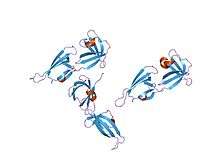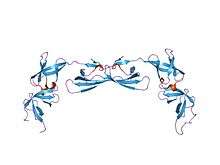Elongation factor P
EF-P (elongation factor P) is an essential protein that in eubacteria stimulates the formation of the first peptide bonds in protein synthesis.[1][2] Studies show that EF-P prevents ribosomes from stalling during the synthesis of proteins containing consecutive prolines.[1] EF-P binds to a site located between the binding site for the peptidyl tRNA (P site) and the exiting tRNA (E site). It spans both ribosomal subunits with its amino-terminal domain positioned adjacent to the aminoacyl acceptor stem and its carboxyl-terminal domain positioned next to the anticodon stem-loop of the P site-bound initiator tRNA.[3] The EF-P protein shape and size is very similar to a tRNA and interacts with the ribosome via the exit “E” site on the 30S subunit and the peptidyl-transferase center (PTC) of the 50S subunit.[4] EF-P is a translation aspect of an unknown function[1], therefore It probably functions indirectly by altering the affinity of the ribosome for aminoacyl-tRNA, thus increasing their reactivity as acceptors for peptidyl transferase.
| Elongation factor P (EF-P) KOW-like domain | |||||||||
|---|---|---|---|---|---|---|---|---|---|
 crystal structure of translation initiation factor 5a from pyrococcus horikoshii | |||||||||
| Identifiers | |||||||||
| Symbol | EFP_N | ||||||||
| Pfam | PF08207 | ||||||||
| Pfam clan | CL0107 | ||||||||
| InterPro | IPR013185 | ||||||||
| PROSITE | PDOC00981 | ||||||||
| |||||||||
| Elongation factor P (EF-P) OB domain | |||||||||
|---|---|---|---|---|---|---|---|---|---|
 crystal structure of translation elongation factor p from thermus thermophilus hb8 | |||||||||
| Identifiers | |||||||||
| Symbol | EFP | ||||||||
| Pfam | PF01132 | ||||||||
| Pfam clan | CL0021 | ||||||||
| InterPro | IPR001059 | ||||||||
| PROSITE | PDOC00981 | ||||||||
| CDD | cd04470 | ||||||||
| |||||||||
| Elongation factor P, C-terminal | |||||||||
|---|---|---|---|---|---|---|---|---|---|
 crystal structure of translation elongation factor p from thermus thermophilus hb8 | |||||||||
| Identifiers | |||||||||
| Symbol | Elong-fact-P_C | ||||||||
| Pfam | PF09285 | ||||||||
| InterPro | IPR015365 | ||||||||
| SCOPe | 1ueb / SUPFAM | ||||||||
| CDD | cd05794 | ||||||||
| |||||||||
EF-P consists of three domains:
- An N-terminal KOW-like domain
- A central OB domain, which forms an oligonucleotide-binding fold. It is not clear if this region is involved in binding nucleic acids[5]
- A C-terminal domain which adopts an OB-fold, with five beta-strands forming a beta-barrel in a Greek-key topology[5]
Eukaryotes and archaebacteria lack EF-P. In eukaryotes, a similar function is performed by the eukaryotic initiation factor, eIF-5A, which exhibits some modest sequence and structural similarity with EF-P.[2][6]. There are, however, many difference differences between EF-p and eIF-5A. EF-P has a structure similar to that of L-shaped tRNA and it contains three (I,II and III) β-barrel domains. In contrast, eIF-5A contains only two domains (C and N).[2][7] Moreover, as opposed to eIF-5A, which contains the non-proteinogenic amino acid hypusine that is essential for its activity, EF-P undergoes no post-translational amino acid modifications. Finally EF-P is about 40 amino acids longer than shorter than eIF-5A.
Function
In eubacteria, there are three groups of factors that promote protein synthesis: initiation factors, elongation factors and termination factors.[7] The elongation phase of translation is promoted by three universal elongation factors, EF-Tu, EF-Ts, and EF-G.[8] EF-P was discoverd in 1975 by Glick and Ganoza,[9] as a factor that increased the yield of peptide bond formation between initiator fMet-tRNAfMet and a mimic of aa-tRNA, puromycin (Pmn). The low yield of product formation in absence of EF-P can be described by the loss of peptidyl-tRNA from the stalled ribosome. Thus, EF-P is not a necessary component of minimal in vitro of translation system, however, the absence of EF-P can limit translation rate, increase antibiotic sensitivity, and slow growth.
To complete its function, EF-P enters paused ribosomes through the E-site and facilitates peptide bond formation through interactions with the P-site tRNA.[10] EF-P and eIF-5A both are essential for the synthesis of a subset of proteins containing proline stretches in all cells.[1]
It has been suggested that after binding of the initiator tRNA to the P/I site, it is correctly positioned to the P site by binding of EF-P to the E site.[11] Additionally, EF-P has been shown to assist in efficient translation of three or more consecutive proline residues.[12]
Structure
EF-P is a 21 kDa protein encoded by the efp gene.[8] EF-P consists of three β-barrel domains (I,II and III) and has a L shape tRNA structure. Domain II and III of EF-P are similar to each other. Despite the structural similarity of EF-P with tRNA, studies showed that, EF-P does not bind to the ribosome at the classical tRNA binding site, but at the distinct position that is located between the P and E sites.[3]
See also
References
- Lk, Doerfel; I, Wohlgemuth; C, Kothe; F, Peske; H, Urlaub; Mv, Rodnina (2013-01-04). "EF-P Is Essential for Rapid Synthesis of Proteins Containing Consecutive Proline Residues". Science. 339 (6115): 85–8. Bibcode:2013Sci...339...85D. doi:10.1126/science.1229017. PMID 23239624.
- K, Hanawa-Suetsugu; S, Sekine; H, Sakai; C, Hori-Takemoto; T, Terada; S, Unzai; Jr, Tame; S, Kuramitsu; M, Shirouzu (2004-06-29). "Crystal Structure of Elongation Factor P From Thermus Thermophilus HB8". Proceedings of the National Academy of Sciences of the United States of America. 101 (26): 9595–600. Bibcode:2004PNAS..101.9595H. doi:10.1073/pnas.0308667101. PMC 470720. PMID 15210970.
- G, Blaha; Re, Stanley; Ta, Steitz (2009-08-21). "Formation of the First Peptide Bond: The Structure of EF-P Bound to the 70S Ribosome". Science. 325 (5943): 966–70. Bibcode:2009Sci...325..966B. doi:10.1126/science.1175800. PMC 3296453. PMID 19696344.
- Sara Elgamal1 , Assaf Katz1,2*, Steven J. Hersch3 , David Newsom, Peter White4,5, William Wiley Navarre3 , Michael Ibba1 (August 2014). "EF-P Dependent Pauses Integrate Proximal and Distal Signals during Translation". Doi:10.1371/Journal.pgen.1004553. 10 (8): e1004553. doi:10.1371/journal.pgen.1004553. PMC 4140641. PMID 25144653.CS1 maint: multiple names: authors list (link)
- Hanawa-Suetsugu K, Sekine S, Sakai H, Hori-Takemoto C, Terada T, Unzai S, Tame JR, Kuramitsu S, Shirouzu M, Yokoyama S (June 2004). "Crystal structure of elongation factor P from Thermus thermophilus HB8". Proc. Natl. Acad. Sci. U.S.A. 101 (26): 9595–600. Bibcode:2004PNAS..101.9595H. doi:10.1073/pnas.0308667101. PMC 470720. PMID 15210970.
- Rossi, D; Kuroshu, R; Zanelli, CF; Valentini, SR (2013). "eIF5A and EF-P: two unique translation factors are now traveling the same road". Wiley Interdisciplinary Reviews. RNA. 5 (2): 209–22. doi:10.1002/wrna.1211. PMID 24402910.
- Jh, Park; He, Johansson; H, Aoki; Bx, Huang; Hy, Kim; Mc, Ganoza; Mh, Park (2012-01-20). "Post-translational Modification by β-Lysylation Is Required for Activity of Escherichia Coli Elongation Factor P (EF-P)". The Journal of Biological Chemistry. 287 (4): 2579–90. doi:10.1074/jbc.M111.309633. PMC 3268417. PMID 22128152.
- Lk, Doerfel; Mv, Rodnina (June 2013). "Elongation Factor P: Function and Effects on Bacterial Fitness". Biopolymers. 99 (11): 837–45. doi:10.1002/bip.22341. hdl:11858/00-001M-0000-0013-F8DD-5. PMID 23828669.
- B R Glick, M C Ganoza. 1975. Identification of a soluble protein that stimulates peptide bond synthesis. Proceedings of the National Academy of Sciences, Nov , 72 (11) 4257-4260; DOI: 10.1073/pnas.72.11.4257
- Tollerson, Rodney; Witzky, Anne; Ibba, Michael (2018-10-23). "Elongation factor P is required to maintain proteome homeostasis at high growth rate". Proceedings of the National Academy of Sciences. 115 (43): 11072–11077. doi:10.1073/pnas.1812025115. ISSN 0027-8424. PMC 6205485. PMID 30297417.
- Leaps in Translational Elongation Science (2009) 326, 677.
- Ude, Susanne; Lassak, Jürgen; Starosta, Agata L.; Kraxenberger, Tobias; Wilson, Daniel N.; Jung, Kirsten (2013-01-04). "Translation Elongation Factor EF-P Alleviates Ribosome Stalling at Polyproline Stretches". Science. 339 (6115): 82–85. Bibcode:2013Sci...339...82U. doi:10.1126/science.1228985. ISSN 0036-8075. PMID 23239623.